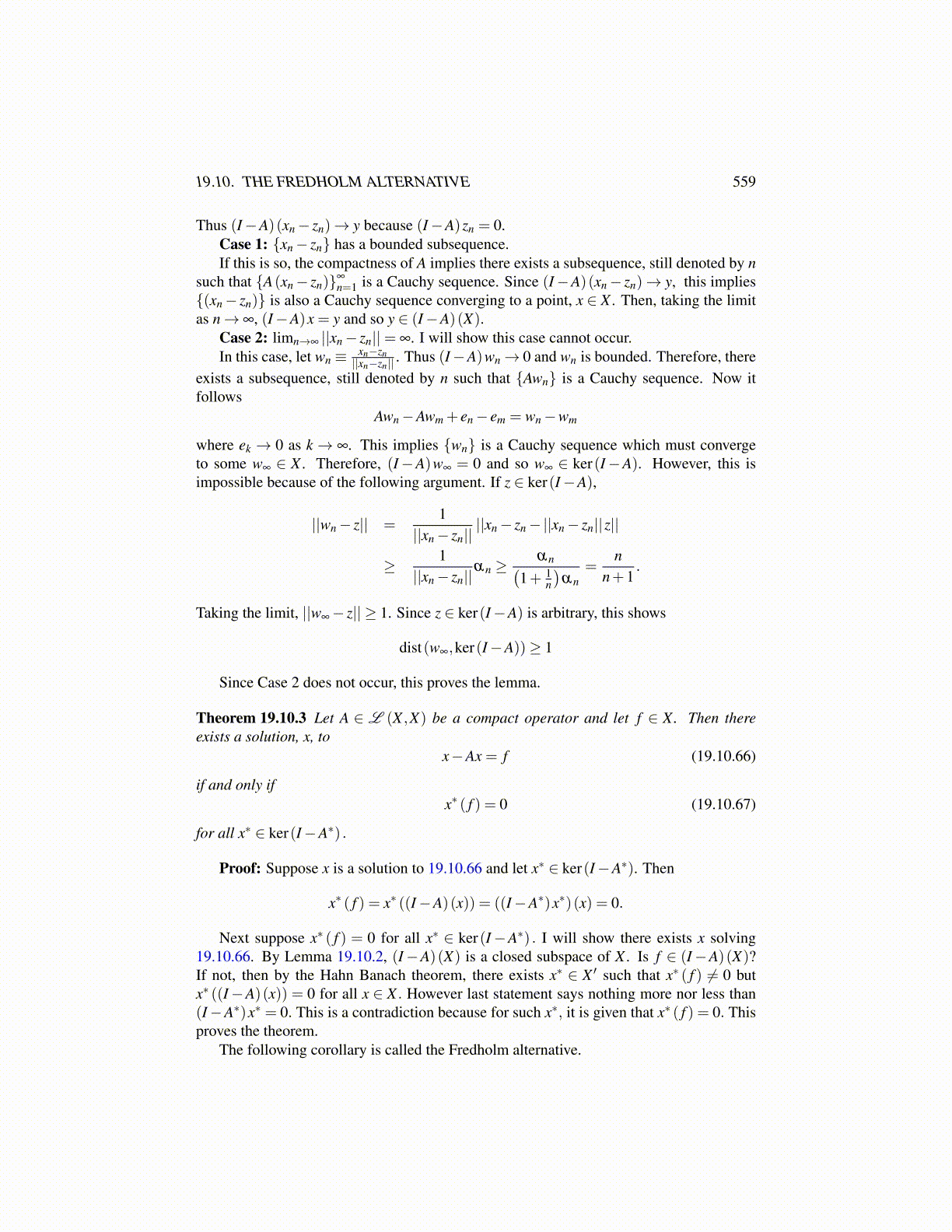
19.10. THE FREDHOLM ALTERNATIVE 559
Thus (I−A)(xn− zn)→ y because (I−A)zn = 0.Case 1: {xn− zn} has a bounded subsequence.If this is so, the compactness of A implies there exists a subsequence, still denoted by n
such that {A(xn− zn)}∞
n=1 is a Cauchy sequence. Since (I−A)(xn− zn)→ y, this implies{(xn− zn)} is also a Cauchy sequence converging to a point, x ∈ X . Then, taking the limitas n→ ∞, (I−A)x = y and so y ∈ (I−A)(X).
Case 2: limn→∞ ||xn− zn||= ∞. I will show this case cannot occur.In this case, let wn ≡ xn−zn
||xn−zn|| . Thus (I−A)wn→ 0 and wn is bounded. Therefore, thereexists a subsequence, still denoted by n such that {Awn} is a Cauchy sequence. Now itfollows
Awn−Awm + en− em = wn−wm
where ek → 0 as k→ ∞. This implies {wn} is a Cauchy sequence which must convergeto some w∞ ∈ X . Therefore, (I−A)w∞ = 0 and so w∞ ∈ ker(I−A). However, this isimpossible because of the following argument. If z ∈ ker(I−A),
||wn− z|| =1
||xn− zn||||xn− zn−||xn− zn||z||
≥ 1||xn− zn||
αn ≥αn(
1+ 1n
)αn
=n
n+1.
Taking the limit, ||w∞− z|| ≥ 1. Since z ∈ ker(I−A) is arbitrary, this shows
dist(w∞,ker(I−A))≥ 1
Since Case 2 does not occur, this proves the lemma.
Theorem 19.10.3 Let A ∈ L (X ,X) be a compact operator and let f ∈ X. Then thereexists a solution, x, to
x−Ax = f (19.10.66)
if and only ifx∗ ( f ) = 0 (19.10.67)
for all x∗ ∈ ker(I−A∗) .
Proof: Suppose x is a solution to 19.10.66 and let x∗ ∈ ker(I−A∗). Then
x∗ ( f ) = x∗ ((I−A)(x)) = ((I−A∗)x∗)(x) = 0.
Next suppose x∗ ( f ) = 0 for all x∗ ∈ ker(I−A∗) . I will show there exists x solving19.10.66. By Lemma 19.10.2, (I−A)(X) is a closed subspace of X . Is f ∈ (I−A)(X)?If not, then by the Hahn Banach theorem, there exists x∗ ∈ X ′ such that x∗ ( f ) ̸= 0 butx∗ ((I−A)(x)) = 0 for all x ∈ X . However last statement says nothing more nor less than(I−A∗)x∗ = 0. This is a contradiction because for such x∗, it is given that x∗ ( f ) = 0. Thisproves the theorem.
The following corollary is called the Fredholm alternative.